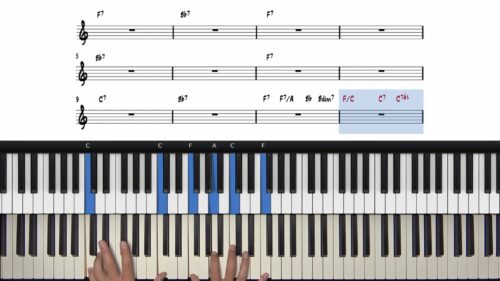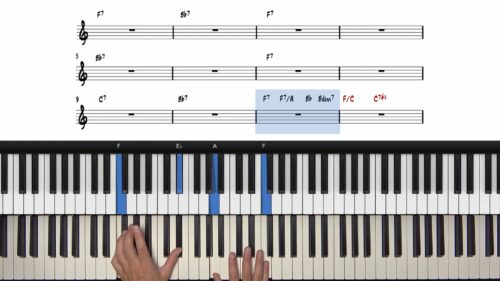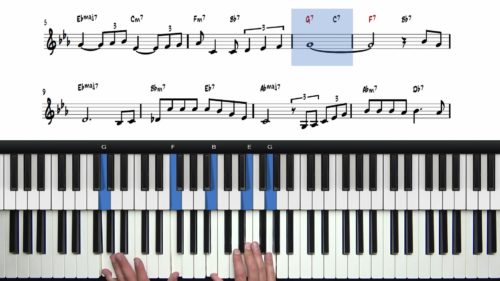Blues Scale Turnarounds
In this lesson we embellish the turnaround section using blues scales. We introduce blues scale phrases and licks that are built from both the major and minor blues scales and we examine which chords are suited to which blues scale variation.
The minor blues scale is well-suited to the harmony of the IV chord, and the major blues scale works well over the I and V chords. Towards the end of the lesson we intertwine both major and minor blues scale embellishments in a single turnaround phrase.
Apply To The Different Registers
Shifting the blues scale phrases and licks up and down the keyboard to the different octaves can be used to create textural effects and voicing possibilities. We apply the same blues scale phrases in the middle of the piano, and also in the higher and lower octaves.
Turnaround Options
Remember that using blues scales in the turnaround passage is just one of many options that we have available to us. In this module we cover 4 distinctly different approaches to navigating the turnaround and so be sure to practice these individually and apply them spontaneously and creatively when playing the 12 bar blues.
Lesson Downloads
-
Blues Scale Turnarounds File Type: pdf
Practice Tips
-
Understand the distinction between the minor and major blues scales and the harmonic situations where they are best suited.
-
The F major blues scale works well over the I and V chords, and the F minor blues scale pairs well with the IV chord.
-
Be patient when learning the blues scale licks, breaking them down into smaller fragments if necessary.
-
Isolate the licks in your right hand and once you are comfortable with the shapes you can combine them with the left hand bass lines and chordal movements.
- Practice the blues licks and blues phrases slowly, focusing on accuracy, and gradually speed up the tempo.








I played at my yacht club Thursday night Hayden. The blues in F which I once again applied to Driftin Blues. I got a standing ovation and asked not to stop!
It felt good Hayden. You are an outstanding teacher, and I am a humble student. You are beyond your young years Hayden!
Thank you my friend.
Cheers :-)
Hey Glenn 👋 – thanks for letting me know and it makes me really happy to hear that. I would have loved to have heard your yacht club performance! Congrats on the public performance as I know it can be intimidating but it gets easier and easier the more we do it.
I have a passion for the blues and so I’m having a blast creating these lessons and also learning more about the style myself. I think I mentioned already but I’m happy that you requested this in the seminar section as that was the original motivation to start this course.
I always have a backlog of requests for different styles and tunes to cover etc… and this is one that I am particularly enjoying working on.
I’m still mapping out the improvisation module and I have some cool things to share so far.
I’m also going to do some lessons on left hand tricks. There so many avenues to explore with the style!
As mentioned I have some material ready to teach which incorporates the Ray Charles tune that you like, and also I’m absorbing the walk up and sus chord techniques used in the “hipster blues stormy monday” video that you sent me. The latter will be great for a lesson on sus chords in the slow blues which I had already planned to cover.
I’m aiming to get more lessons recorded this week so keep an eye on the course page for new additions.
Talk soon, Hayden
I know from my personal experience that fingerings are a pretty personal subject. Yet, if a person who masters the subject – the teacher – gives the student an idea on how the fingerings may look like, then this a great help for the student. He gets a first version of a feasible fingering, which he then can modify to his hands, their size, elasticity etc etc.
Can you give me your fingerings specifically the more complicated areas with the grace notes, please?